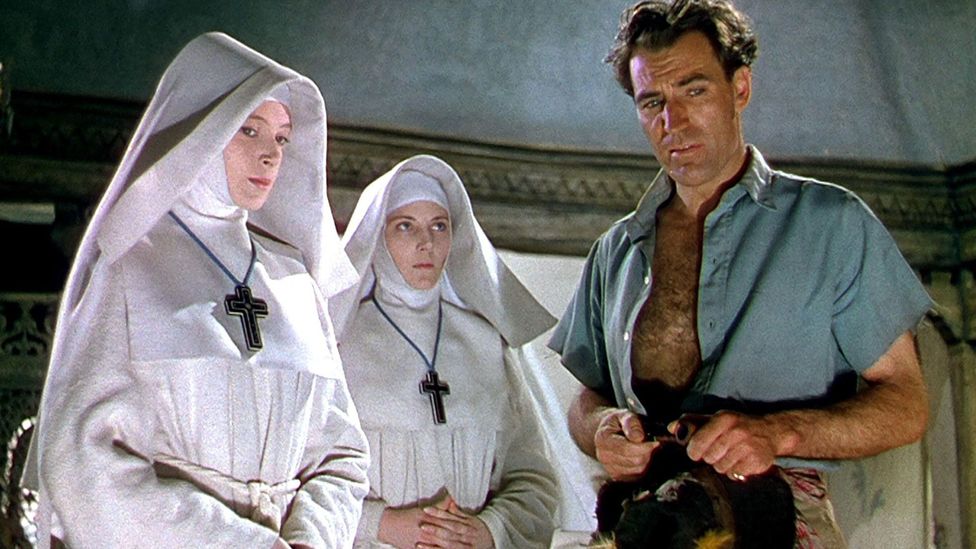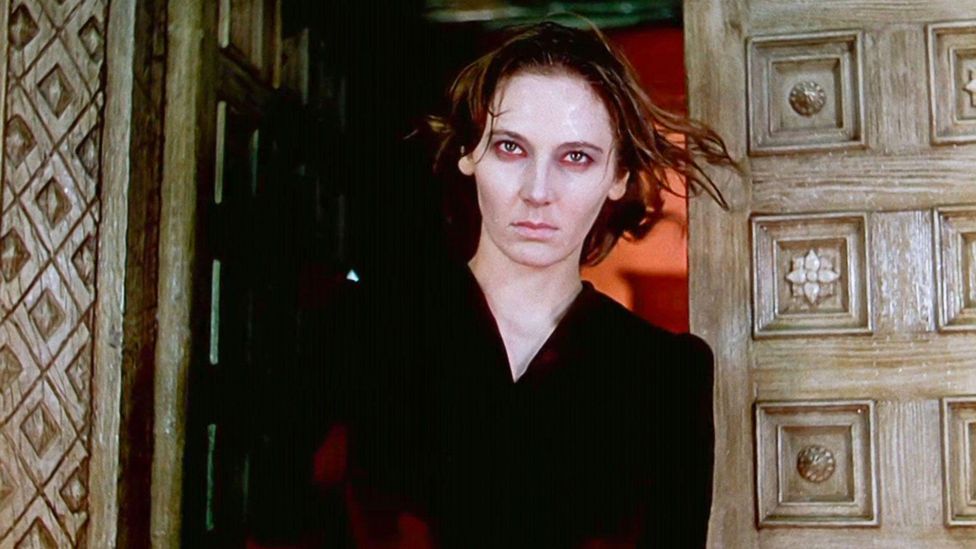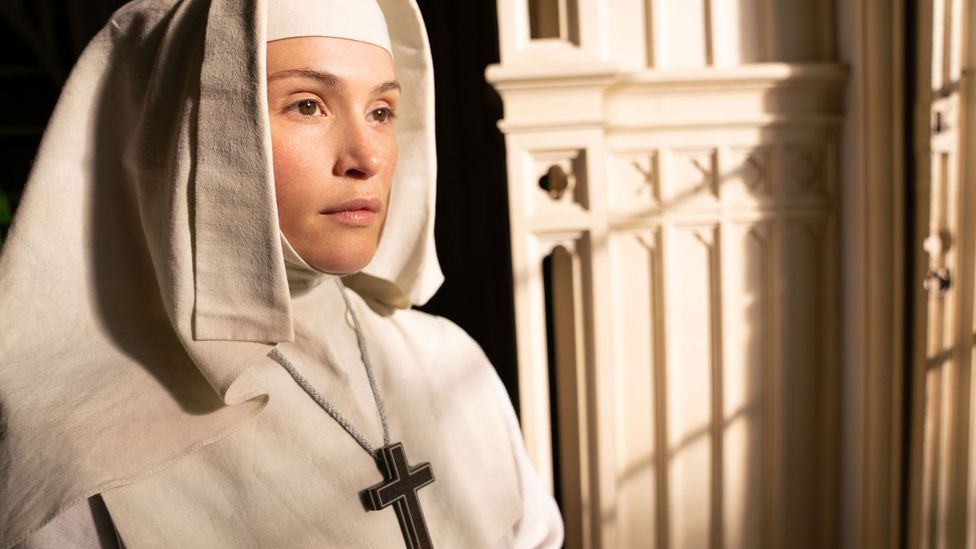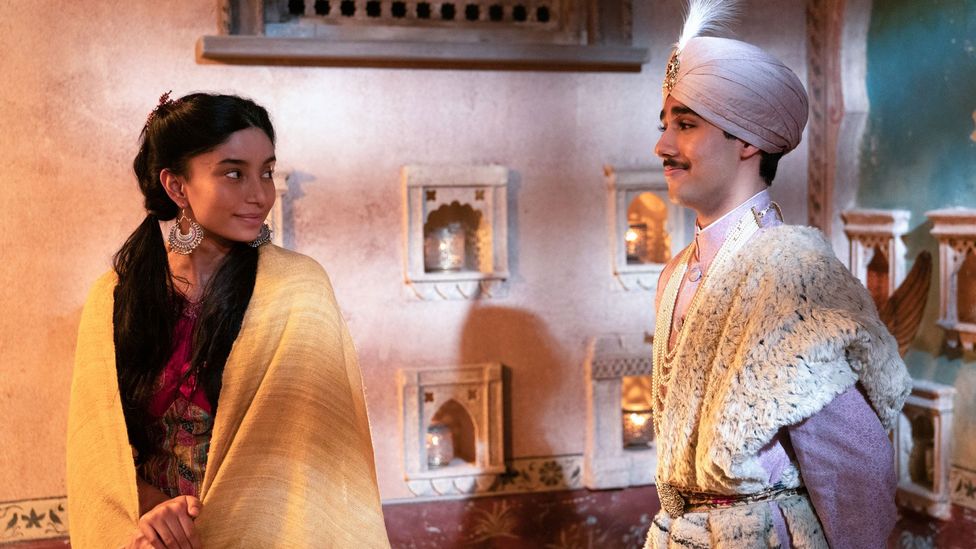What began as a 1930s novel about troubled nuns in the Himalayas led, a few years on, to a film classic. Now as a new TV version begins, Neil Armstrong explores the story’s dark power.
“The Sisters left Darjeeling in the last week of October. They had come to settle in the General’s Palace at Mopu, which was now to be known as the Convent of St Faith.”
More like this:
– The secrets of TV’s best thriller writer
– Eight TV shows to watch in November
– How Showgirls exposed our misogynistic culture
There is nothing in the innocent opening sentences of Rumer Godden’s 1939 novel Black Narcissus to suggest that the subsequent film version would be butchered by censors, banned, and eventually hailed as “one of the first truly erotic films” by one of the world’s great directors – Martin Scorsese.

Black Narcissus tells the story of a group of nuns who find themselves overcome by repressed desire when they move to a Himalayan retreat (Credit: Alamy)
That movie was made by an English director and a Hungarian-born writer-producer: Michael Powell and Emeric Pressburger, the celebrated cinema partnership revered for a series of groundbreaking and influential British films, of which Black Narcissus has become one of the best-loved. Now, there is a new adaptation, this time a joint BBC-FX production made for the small screen and starring Gemma Arterton and Aisling Franciosi.
The book, Godden’s third, and first bestseller, was praised by critics for its “rare beauty” and its “subtlety and freshness”, yet the story is not commonly described in such terms now. Rather Amanda Coe, the writer of the new three-part television version, says she thinks of it as “The Shining with nuns”.
Godden, who died aged 90 in 1998, was born in England but spent much of her childhood in India where her father managed a steamship company. She was a bestselling author who wrote more than 60 books, several of which were filmed. However her popularity has waned to the point where the most familiar Rumer to some will be the actress daughter of Bruce Willis and Demi Moore, apparently named after the writer.
Black Narcissus is Godden’s best-known work, partly because of the success and enduring popularity of the 1947 film. It tells the story of a small cadre of nuns from an Anglo-Catholic order sent to a remote mountaintop palace 8,000ft (2,400m) up in the Himalayas to establish a school and dispensary for the ‘natives’ – whether the ‘natives’ want one or not. The young, relatively inexperienced and rather self-important Sister Clodagh is placed in charge of this mission. Among the nuns is the highly-strung, difficult Sister Ruth.
The palace is an unsettling place, perched vertiginously on the edge of a gorge and constantly buffeted by the wind. “I think you can see too far,” one of the nuns says. The locals know the building as the House of Women because, in the past, the region’s ruler kept his harem there. It is still filled with the ghosts of bygone days. The air may be thin, but the atmosphere is thick.
The longer they spend in this wild, elemental place, the more the women’s religious calling is clouded by very earthly desires. One becomes obsessed by her garden, planting it with flowers instead of vegetables. The nun who is particularly good with children yearns for a baby of her own. Sister Clodagh is troubled by memories of a youthful love affair and the increasingly tormented Sister Ruth lusts after Mr Dean, a somewhat dissolute Englishman who lives in the village. There are further ripples in the undercurrent of repressed longing when the handsome young nobleman being educated by the nuns has his head turned by Kanchi, a beautiful village girl. Eventually, the undercurrent becomes a torrent and the dam breaks
Spicing the story up
The sexual themes are understated in the novel but when Powell read it, he felt “the story, so coolly told in excellent prose, would be wildly exotic and erotic on the screen”, as he wrote in his memoir. Powell’s creative partner, Pressburger, took Godden to lunch and seems to have outlined their plans to emphasise the sexual elements of the story because, according to her biography, she thought he would “treat Black Narcissus right if he ever gets it past the censor”.

As the mad, bad and dangerous to know Sister Ruth, Kathleen Byron gives the most memorable performance in the original 1947 film (Credit: Alamy)
In 1946, when Powell and Pressburger started planning the film, they were already a successful team, having made The Life and Death of Colonel Blimp (1943) and A Canterbury Tale (1944). They would become even more so that year with the release of A Matter of Life and Death, selected for the first ever Royal Film Performance.
They quickly decided that shooting Black Narcissus in India would be too costly and difficult – but they viewed that as a positive, says Sarah Street, Professor of film at the University of Bristol and author of a book on the film. “I think Powell saw it as a fantastic opportunity to do great stuff in the studio,” she says. “That very precise controlled production environment allowed him a huge degree of control over the sense of place. He was able to depict the East as incredibly sensual and exotic, but the Himalayas were actually created in Pinewood and at Leonardslee, a sub-tropical garden in Horsham, West Sussex.”
Deborah Kerr was cast as Clodagh, and Kathleen Byron as Ruth. The fact that Powell had had affairs with both no doubt added to the creative tension. He claimed that Byron had once pulled a gun on him, writing in his autobiography: “A naked woman and a loaded gun are persuasive objects.” The actress dismissed that story but recalled: “When I was offered Black Narcissus, Michael Powell sent me a telegram saying, ‘We’re offering you the part of Sister Ruth; the trouble is, you’ll never get such a good part again!’ He was more or less right.” Years after the film’s release, members of the public would still recognise her as “the mad nun”. Although Byron’s character – mad, bad and dangerous to know – was the one that everyone remembers, Street discovered that she was paid just GBP900 for 44 days’ work; Kerr was paid GBP16,000 for 55 days.
The evolution of a cult classic
British audiences liked the film, the critics were ambivalent (although cinematographer Jack Cardiff won an Oscar for it) and Rumer Godden hated it. According to an obituary, she complained that “everything about it was phoney… the Himalayas were just muslin mounted on poles”. The Catholic Legion of Decency in the US was unhappy with it too, kicking up such a fuss that Sister Clodagh’s flashbacks to her life before she was a nun were all cut, along with a couple of other scenes. And the film was initially banned in Ireland because of, the censor said, “a sex atmosphere right through the picture which many will regard as a travesty of convent life”.
It was reassessed in the 1970s and is now regarded as a classic, championed by Scorsese and Francis Ford Coppola among others. Scorsese has loved Powell and Pressburger films since he was a child and has said that every time he saw the logo of The Archers – the pair’s production company – at the start of a film, he knew he was “in for something special”.
He dubbed Black Narcissus “one of the first truly erotic films” in an audio commentary for a DVD release. Anyone who doubts it should watch the scene towards the end in which Sister Clodagh visits the room of a frenzied, wild-eyed Sister Ruth, who has cast aside her habit in favour of a sexy crimson dress. With beads of perspiration on her forehead, Ruth taunts the horrified Clodagh by suggestively applying garish red lipstick to her moist lips – shot in glorious Technicolor and sensual close-up. The scene was one of those cut in the US. “The moment with the lipstick is incredible,” says Street. “By itself it is a very sensual scene but, also, within the drama it represents the fear that the person that Ruth has become might also be lurking in any of the other nuns.”

The upcoming BBC/FX adaptation stars Gemma Arterton in the lead as the inexperienced and self-important Sister Clodagh (Credit: FX)
There is a version of the scene in the new TV adaptation. “There are certain things that people who want to watch this because they love the film will expect,” says Coe. “You’ve got to deliver. Otherwise it would be like seeing Hamlet and he doesn’t do ‘To be or not to be’.” Arterton is Sister Clodagh and Franciosi is Sister Ruth, in this production, which also briefly features the late Diana Rigg in what was to be her last TV role. (Rigg starred in a screen adaptation of another Godden story about nuns – 1975 TV movie In This House of Brede).
Black Narcissus for a new era
The mini-series pays homage to the Powell and Pressburger classic while building a quietly powerful atmosphere that is very much its own. The melodrama has been toned down and certain themes – the decline of the British Empire, for example – teased out more. The cast are excellent, with several secondary characters making a strong impression, such as Patsy Ferran as sweet Sister Blanche and Karen Bryson as the flower-obsessed Sister Philippa, who becomes aware of the dangers of Mopu.
Mr Dean is played by Alessandro Nivola, who was already familiar with the movie because his wife, Emily Mortimer, had been given it to watch as homework by Scorsese when she worked with the director on 2010 psychological thriller Shutter Island. “One of his big inspirations for the way that he wanted to shoot Shutter Island was Black Narcissus,” Nivola tells BBC Culture. “He made it required viewing for all of the actors, so I remember her [Mortimer] coming home and saying: ‘Marty says we have to watch this movie’. That was the first time that I’d seen it. It just seemed so strange and gothic and just bizarre. I remembered how potent all of the kind of sexuality was in it, without it being explicit in any way.”
Indeed, for all its sexual undertow, the film is opaque enough to crop up on Sunday afternoons on terrestrial television without complaint. “I’ve written a lot of things that have quite explicit sexual content – it’s a running joke in my family that I never write anything that either my mother or my children could watch,” says Coe. “This, I feel, everybody could watch but in a way it’s the most erotic, twisted thing that I’ve worked on because it’s all so repressed. One aspect of the story is that it’s like The Shining with nuns. Mopu is like the Overlook Hotel, a very isolated place in which the nuns, all in their own way, start to go slightly mad.”
There is an element of continuity between the Powell and Pressburger film and the miniseries. One of the co-producers of the latter is Andrew Macdonald, grandson of Pressburger. A crew member is a great-granddaughter of Godden. And, although some filming was done in Nepal, interiors were filmed on sets built at Pinewood.
However, there is an important difference. The film is currently available on the streaming platform Britbox where it comes with a warning – but it’s nothing to do with sexual or religious content. “This classic drama features ‘blackface’ performances that may offend,” it says, a mark of changing social mores.

The new TV version makes one important change from the film, in casting ethnically appropriate actors, including Dipika Kunwar (left) and Chaneil Kular (right) (Credit: FX)
Jean Simmons, a white actress, played Kanchi in the original. There was only one Indian cast member: Sabu, who was the dandyish Young General, seeking an education from the sisters. (The character loves the heady perfume – Black Narcissus – which gives the work its name. Narcisse Noire by Caron is still available). In the new version, there is a more ethnically diverse cast. Kanchi, for example, is portrayed by Dipika Kunwar, a British-Nepalese actress making her screen debut.
The series will undoubtedly inspire some viewers to try Godden’s book. A handsome new hardback edition is being published as a Virago Modern Classic to coincide with it. Coe has written the introduction. She describes the novel as “a gorgeous poetics of the female, spanning sex, spiritual yearning, and the yen to plant sweet peas. I can’t think of another piece of writing quite like it.”
Black Narcissus is released on FX and Hulu on 23 November, and is coming to BBC One this December.
Love film and TV? Join BBC Culture Film and TV Club on Facebook, a community for cinephiles all over the world.
If you would like to comment on this story or anything else you have seen on BBC Culture, head over to our Facebook page or message us on Twitter.
And if you liked this story, sign up for the weekly bbc.com features newsletter, called The Essential List. A handpicked selection of stories from BBC Future, Culture, Worklife and Travel, delivered to your inbox every Friday.


